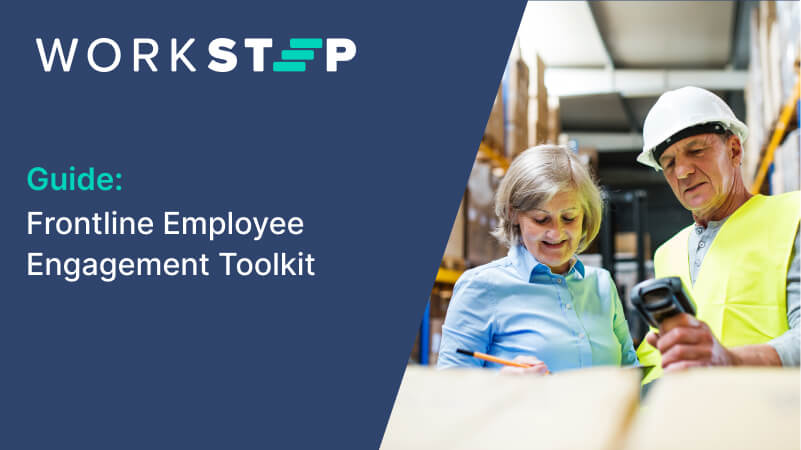Data-driven insights: How frontline employee engagement impacts the bottom line
October 19, 2023
Frontline employees are the heart of a company – yet many organizations overlook a crucial component that directly affects their profitability: frontline employee engagement. They are the faces that greet customers in every storefront, the drivers who traverse thousands of miles, and the workers who spend hours on their feet making sure the shelves are stocked. While executives make sweeping operational decisions, explore new initiatives, and make decisions to benefit the bottom line – it is our frontline workers who must execute on many of the strategic initiatives.
As the business landscape continues to evolve, the spotlight now rests on frontline employees. From retail associates to customer service representatives, these individuals play a pivotal role in shaping customer experiences. But what is the tangible link between frontline employee engagement and the bottom line?
Customer satisfaction and loyalty
It may seem counterintuitive at first, but a successful customer experience (Cx) solution does not start with the people who pay you for your services – it begins with your employees. Results from the International Data Corporation’s (IDC) Enterprise Resiliency and Spending (FERS) survey found that 85% of respondents agreed that they saw improvements to their customer experience, including customer satisfaction, as well as increased revenue after bolstering their employee experience.
Additionally, 62% of IDC’s respondents identified a relationship between employee and customer experiences, stating that the impact was significant and measurable. Keeping that in mind, it should come as no surprise that over half of those surveyed claim that customer satisfaction has become a primary metric when evaluating productivity.
The facts paint a clear picture, frontline employees who are engaged tend to provide better customer service. They are more attentive, proactive, and enthusiastic, which directly translates into positive customer experiences.
Satisfied customers are more likely to become repeat customers and even brand advocates, which can lead to increased sales and customer retention.
Satisfied employees translate to satisfied customers, simple as that. In fact, 92% of executives believe that engaged employees offer better services, leading to 10% higher customer ratings and an impressive 23% increase in profitability.
Productivity, efficiency, and their undeniable link to engagement
Productivity and efficiency are the cornerstones of any thriving business. But what drives them? Recent Harvard Business Review studies have drawn a direct correlation between frontline employee engagement and enhanced organizational performance. In fact, the report indicated that companies with high employee engagement levels outperform their competitors by as much as 22%. This isn’t a mere coincidence; an engaged frontline employee is more inclined to put in more effort, leading to higher efficiency.
Another compelling statistic from Gallup reveals that teams in the top 20% of engagement scores experience up to a 41% reduction in absenteeism and a staggering 59% lower attrition. Fewer absentees mean consistent service quality and enhanced productivity, while the cost of replacing an employee can be 90%-200% of their annual salary. The rationale behind this is straightforward: when employees feel valued, heard, and connected to their company’s mission, they’re less likely to take unscheduled off days, ensuring operations run smoothly.
TOOLKIT
The Frontline Employee Engagement Toolkit
A comprehensive resource for HR & Ops leaders designed to help you enhance your frontline’s experience and directly measure the impact on business outcomes.
Bolster innovation by creating careers, not jobs
Competitive industry is driven by innovation, it’s a force that keeps companies relevant and thriving. What many businesses often overlook, is the profound connection between innovation and the engagement of their frontline employees. Engaged employees are not just more productive and loyal; they also have great ideas to bring to the table. Let’s see how frontline employee engagement can be a game-changer for innovation.
Frontline employees are the first to interact with customers, products, and services. Their daily experiences offer them a unique, ground-level perspective on what’s working and what’s not. This first-hand experience equips the common frontline employee to share more informed, practical, insights that are better aligned with the flow of day-to-day operations.
A recent Gallup study found that disengaged employees cost U.S companies an estimated $550 billion in potential profits due to lack of innovation. This highlights the fact that once employees become disconnected, they simply show up to their 40-hour work week without making any strides to improve the business, the product, or their workflow. If you ask, a resounding 95% of employees recognize when they start to feel disengaged, citing poorly written job descriptions, mistrust among colleagues, or lack of meaningful tasks.
Frontline employee engagement has improved dramatically over the past few decades, with a historical high of 35% of employees feeling engaged. The other side of that coin is a less appealing metric to come to terms with, that 65% of employees are doing the bare minimum to keep their jobs, are disconnected from the company mission, and are willing to jump ship with the promise of better hours or a few extra dollars showing up in their paycheck.
All of this is to say that employee engagement plays a pivotal role in creating an innovative environment where everyone involved is compelled to push the company to new heights. This personal investment propels them to go beyond their assigned tasks, inspiring them to think outside the box. They’re more likely to share insights, feedback, and novel ideas that could potentially revolutionize business processes or offerings.
Measuring the ROI of employee engagement and culture
Return on investment (ROI) serves as a critical metric to determine the efficiency and profitability of an expenditure. Employee engagement, often viewed as an intangible aspect of a company, surprisingly has tangible and compelling ROI figures. So, how does positive employee engagement affect a company’s bottom line?
A 2022 report from the Harvard Business Review (HBR) found that tenured representatives with more experience in retail storefronts generated more sales – from $57 per person-hour worked to $87 per person-hour. Additionally, operating profits showed that improvements to the employee experience resulted in a 45% increase in profits per person-hour, from $41 to $59.
According to Bruce Temkin, co-founder of the Customer Experience Professionals Association, “Customer experience leaders have 1.5 times as many engaged employees.” That is because engaged, invested employees are more willing to go above and beyond for their customers, are more knowledgeable, and tend to have a more stable emotional baseline than a disengaged worker – all leading to more positive customer interactions.
In fact, according to a global Aon Hewitt analysis of 94 companies, each 1% of employee engagement improvement correlates to 0.6% in sales growth for the organization. This goes well beyond sales alone, with Gallup reporting that high engagement is associated with a 24.5% larger share price growth when compared to low engagement organizations. Astonishingly, when employees believe in the product and are actively invested in growing the brand, share price growth nearly doubles to 51% with more than half the companies in the dataset outperforming the Dow Jones index by two times.
One team, one mission, one success story
Frontline employees are left on an island within many organizations. They clock in, do the grunt work, and are disconnected from the decision makers that shape their experience. In fact, nearly 4 in 10 (37%) of frontline workers don’t feel as valued as their desk-based peers.
Fostering a culture of engagement amongst frontline employees isn’t just a good HR strategy; it’s a business imperative. As organizations strive to enhance their productivity and efficiency metrics, they must recognize and prioritize the direct impact of frontline employee engagement on these outcomes.
The benefits of engaging your frontline workers directly span across various aspects of a business, from increased sales to reduced costs, from more productivity to less safety incidents. In an ever-competitive global market, your frontline workers are engaged isn’t just a ‘nice-to-have’; it’s essential for companies looking to optimize profitability and growth.
Key research linking CX & EX:
- International Data Corporation’s (IDC) Enterprise Resiliency and Spending (FERS) survey found that 85% of respondents saw improvements to their customer experience as well as increased revenue after bolstering their employee experience.
- 92% of executives believe that engaged employees offer better services, leading to 10% higher customer ratings and 23% increase in profitability.
- Harvard Business Review claims that companies with high employee engagement levels outperform their competitors by as much as 22%
- Gallup found that disengaged employees cost U.S companies an estimated $550 billion in potential profits due to lack of innovation.
- Aon Hewitt found that every 1% of employee engagement improvement correlates to 0.6% in sales growth for the organization
- Nearly 4 in 10 (37%) of frontline workers don’t feel as valued as their desk-based peers.
Tom Goyette, Product Marketing Manager | tom.goyette@workstep.com
Tom Goyette is a Product Marketing Manager at WorkStep. With experience in start-up and enterprise level SaaS and eCommerce organizations, Tom excels at managing and creating content, marketing, and analytics. Tom believes people are at the center of every great organization and is eager to share stories that highlights the value of the employee voice.



